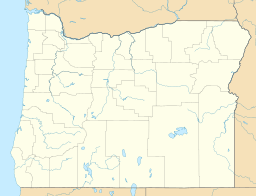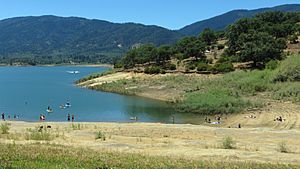Emigrant Lake (Oregon) facts for kids
Quick facts for kids Emigrant Lake |
|
|---|---|

Emigrant Lake
|
|
| Location | Jackson County, Oregon |
| Coordinates | 42°09′41″N 122°36′15″W / 42.16139°N 122.60417°W |
| Type | reservoir |
| Primary inflows | Emigrant Creek |
| Primary outflows | Emigrant Creek |
| Basin countries | United States |
| Surface area | 806 acres (3.26 km2) |
| Water volume | 40,530 acre-feet (49,990,000 m3) |
| Surface elevation | 2,241 feet (683 m) |
Emigrant Lake is a large reservoir (a human-made lake) located about 5 miles (8 km) southeast of Ashland, Oregon. It sits at the southern end of the Rogue Valley.
The lake is 2,241 feet (683 m) above sea level. It covers an average area of 806 acres (3.26 km2). The average amount of water in the lake is 40,530 acre-feet (49,990,000 m3).
Emigrant Lake was created by the Emigrant Lake Dam. This dam is 205 feet (62 m) tall. It holds back the waters of Emigrant Creek. The dam is on the west side of the lake. A spillway, which is a channel for water to flow over or around the dam, is at the northern tip of the lake. Emigrant Creek flows into Bear Creek.
How Emigrant Lake Was Made
The lake was first created in 1924. This happened when the Talent Irrigation District built a concrete arch dam. This first dam was 110-foot (34 m) tall. It was built to help with irrigation (watering crops) and flood control (stopping floods).
Later, in 1960, the United States Bureau of Reclamation made the dam much bigger. They built it into the 204-foot (62 m) rock-filled structure you see today.
Fun at Emigrant Lake
Emigrant Lake has a big recreation area for visitors to enjoy. You can find a campground with 42 spots for RVs and tents. There are also many picnic areas where families can eat and relax.
One of the most exciting features is the two 280-foot (85 m) water slides. These slides are open during the summer months, usually from Memorial Day to Labor Day.
Lake Levels and History Clues
Sometimes, if there isn't much rain, the lake's water level drops very low. In October 2014, for example, the lake was less than 10 percent full. When this happens, old things that were once covered by water can be seen.
Because of this, experts were asked to study the exposed areas. They looked for and protected important historical items that appeared as the water went down.




